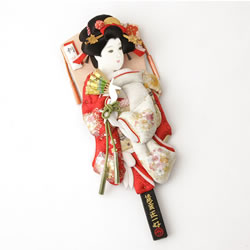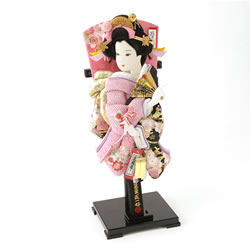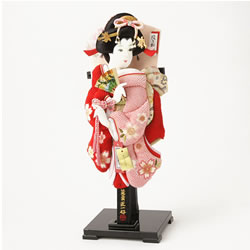Contents > Special > Traditional Craft Edo Oshi-e Hagoita (Edo-Style Decorative Paddles)


※ "Oshi-e" means raised, padded decoration made by affixing thick paper wrapped in silk containing cotton.

These Hagoitas with portraits of beautiful women in kimonos are made by designers and young artisans led by Mr. Sohaku Suzuki, a master Mensoshi (artisan specializing in shaping facial expressions).
Every year, we work on new designs and pursue higher quality works under the guidance of the Sokan (director). Our fine works use the best domestic materials including paulownia from Aizu.
- Ikko
In 14th century China, there was a game in which players would kick a feather with a coin attached to it. It is believed that this game was brought to Japan in the Muromachi period (1337-1587) and became the game of "Hanetsuki", in which players use wooden paddles to hit a shuttlecock.
An ancient document called "Kanban O-nikki" from the Muromachi preiod describes Hanetsuki being played within the Imperial Court. It mentions nobles and ladies of the Imperial Court playing the game, with the losing team made to treat sake to everyone.
Hagoita, which are the wooden paddles used in the game, took on an additional meaning from the Sengoku Period (or Warring States period from mid-15th to early 17th century) when it was believed that the paddles have the power to repel evil spirits. In the Edo Period (1603-1868), people gave Hagoitas at year-end as gifts to wish for good fortune in the coming year. The custom of giving Hagoita as a gift to a newborn girl in the first New Year after her birth still exists today.
During the golden age of the Edo Period ("Genroku Bunka"), decorative Hagoitas with portraits of Kabuki actors (called "Yakusha-e") appeared in addition to the traditional designs of sunrise, Seven Lucky Gods and pine-bamboo-plum representing good fortune. Techniques used in traditional "Nishiki-e" (color woodblock printing) were used to paste designs onto the Hagoita. This "Hari-e Hagoita" eventually became Oshie Hagoita with raised designs. Oshie Hagoita with portraits of famous Kabuki actors were very popular in the Edo Period.
The Meiji Period (1868-1912) saw the arrival of the golden age of Kabuki, with the rise of famous stars including Ichikawa Danjuro IX, Ichikawa Sadanji I and Onoe Kikugoro V. Oshie and Oshie Hagoita matured as a craft of the Tokyo area during this time.
People in ancient times knew that various diseases can be contracted from mosquitoes, and that dragonflies eat mosquitoes. In the game of Hanetsuki, a shuttlecock would fly through the air like a dragonfly as it was hit by paddles. So, people started to play Hanetsuki during the New Year season to wish that their children would not be bitten by mosquitoes.
Also, the hard, black seed of the soapberry plant is often used to make the shuttlecock, as it makes a pleasant clacking sound when hit by a wooden paddle. The Japanese characters for soapberry, "Mukuroji" (無患子) mean "No-Disease-Child."
So, you can see that the the Hagoita paddle has an important meaning as a decorative ornament to celebrate the first New Year of a newborn girl and to wish for the healthy growth of the child in addition to its use as equipment in the game of Hanetsuki.


